
The autumn queen came home again,
she flew with geese by starlight.
Acorn and chestnut called her name,
as did rain and flame and twilight.
This is part of the poem The Autumn Queen which opens
Meidi Goh‘s
first solo EP Heartstrings. Meidi wrote the poem herself and to her it is a portal into her work, her music. After some years studying classical and baroque violin, Meidi started playing with the baroque ensemble Kolibrie. After that she joined the Dutch jazzy folk band
AmmA.
The last year Meidi devided her attention between the Dutch historic folk band
Imbue
and her first solo album.
“After many years in bands I wanted to share my own musical ideas and my own personal stories.” Meidi told me: “This is how Heartstrings was born. I wanted to make music that was a bridge between Elisabethan baroque music and folk. I wanted it to have as pure a sound as possible. I wanted the listener to hear every stroke of the bow over the strings we played. I also wanted the music and my voice to sound as honest as possible. With my perfections but also imperfections, everything as pure as possible. The lyrics straight from my heart, hence the title Heartstrings.” Well I can tell you, she absolutely achieved that.
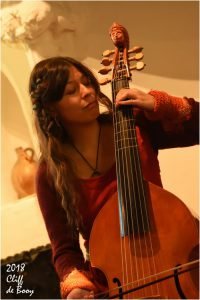 Heartstrings
Heartstrings contains 7 tracks, one poem, one traditional, two covers and 3 original compositions written by herself.
Lovelorn is the first of Meidi’s own compositions and it’s a beautiful ballad. It is, obviously, a love song, a bit melancholic in text and music as most of the songs on
Heartstrings. It tells about a love that is not to be. The string section in this song is already lovely, but what really jumps out are the voices. Meidi has a wonderful skilled soprano. When she goes into the heights of her voice she hits the notes perfectly in what I would call ‘classic’ soprano style, but in the lower regions she returns to her ‘normal’ voice, giving the song so much more personality. Her voice has this youthful fragility and purity that make the hairs stand up. So beautiful. From the beginning I had to think of some of the top young boy sopranos, hearing her voice. And I mean that in the most complimentary of ways.
Everybody who has seen the musical
Oliver Twist for instance, will remember young Oliver singing
Who Will Buy This Beautiful Morning. There is this youthful innocence when he sings that song, one we all know will disappear when he gets older that makes it so touching. Somehow Meidi managed to keep that young and pure quality in her voice, although she is an accomplished singer. And somehow Jacco de Wijs-van Gorcum has managed to capture that while recording the vocals. Of course we know him as one of the frontmen of the Dutch folk metalband
Heidevolk,
but here he proves he is just as talented behind the mixer. Especially in the chorus, where
Hanna van Gorcum
joins Meidi in a call and answer that is as pure as crystal. Stunning.
After I asked Meidi about her singing style, she explained more about it:’ When I was young I grew up with ‘old’ music. Music from the renaissance and baroque era. One of the stand out features of these periods is the different use of vibrato in the music and in the singing. A lot milder and totally different in intensity from how we use it today. In those days people were more interested in purity of sound. And indeed that is just how the boy sopranos sing. That style actually originates from this early period. the heavier use of vibrato started to appear in the 18th century, with the first operas from the classical time period which followed the baroque, and even more so in the romantic period.
Hanna van Gorcum is much more classically trained. You could call my voice an ‘old’ or baroque music voice.’
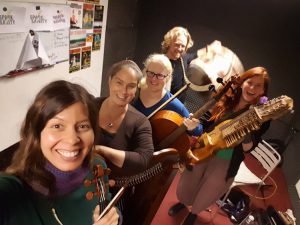
Jacco is not the only talented musician involved in
Heartstrings. I already mentioned Hanna van Gorcum
(
TDW & Dreamwalker inc,
former AmmA) on voice and nyckelharpa. There is also Coca Román
(
Kelten Zonder Grenzen,
Violet)
on harp, Hester de Boer (Violet) on cello and quinton, -a 5 stringed violin that was build and played between early 18th century and the French revolution, you could call it a viola and a violin in one instrument-, and Imbue colleague Tim Elfring on davul. All but Tim join Meidi on the next song,
Waltz For The Little Mermaid, written and partly arranged by Meidi. The other musicians where all given room to arrange their own parts on this song, giving them all a chance to shine.
Meidi insisted that all the songs would be recorded as an ensemble, in one take, keeping with the pure natural feel that she was after, only the vocals were recorded separately. And I can only say, it worked. The songs just sparkle. Jacco did wonders catching it all on tape, and after that, mixing engineer
Fieke van den Hurk
and mastering engineer
Sander van der Heide
made the most of all the quality that they were given.

My favourite track on
Heartstrings is another original composition,
Foxskin. Balfolk people will love this song, I’m sure of it.
This cheerful fun song brings together all the elements that define Meidi Goh’s classical folk style.
It’s the perfect blend between the baroque music that she started out with and the English folk she fell in love with later on in her musical career. English because of the pronunciation of the lyrics.
It is as if
Loreena McKennitt
and
Johann Sebastian Bach
did a baroque minuet / folk CD together. Sounds odd? Maybe but believe me it so makes sense when you hear the songs. The two worlds just blend naturally together in Meidi’s compositions.
The song itself is about a young lady who, at night, turns into a fox to dance with the elves and other magical creatures in the dark woods
My Love Came To Dublin is the first cover I want to mention. It’s a song originally co-written and recorded by
June Tabor.
And it fits perfectly within Meidi’s own songs. I once called
Gwendolyn Snowdon
a storyteller, well Meidi is a poet. And her songs are poetry in music form. The Lyrics of
My Love came To Dublin fit right in, with that slight old English feel. It’s a melancholic song full of longing for an absent lover. The deep sound of the seven stringed bass viol enhances that sad autumn feel and is a lovely contrast to Meidi’s angelic voice. Coca’s harp then enhances the purity of it. Again a lovely song. Recorded and mixed so well.
Konungen Och Trollkvinnan, is another cover. It was originally recorded by the Finnish folkband
Gjallarhorn.
As Gjallarhorn hail from the only part of Finland where Swedish is the main language
Trollkvinnan is a Swedish song, based around the sound of violin and nyckelharpa, this in contrast to the other songs on Heartstrings. This reminds me more of
Kaunan
‘s music or that of the Swiss duo
Knep
on
Bestioles. A CD I reviewed a few months ago.
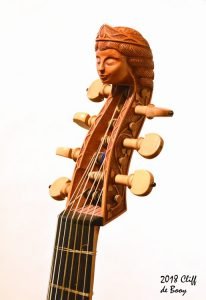
The last song on
Heartstrings is a traditional that goes by the name,
Once I Had A Sweetheart. Hanna starts this song with a lovely nyckelharpa solo. And Meidi once again pours out her melancholic heart on the low tones of her bass viol. She sometimes affectionately calls her bass viol ‘my muse’. This Viola da gamba -the Dutch name for it- was specially made for Meidi’s mother many years ago. -Meidi herself even drew the design of the head- and her mother asked Meidi:’You will play her after I’m gone won’t you? And needless to say Meidi did just that to this very day.
This is a mini CD that will appeal to open minded classical people as much as it will people that enjoy the lovely folk ballads of bands like
AmmA,
Anuna,
and
Rosemary & Garlic
or the more traditional songs from
Loreena McKennitt,
Altan
and the German band
Cara,
(whose new live CD I’ll be reviewing later this year) . Don’t expect fast dancing songs on
Heartstrings, they are all slow to mid tempo ballads. But there are some nice balfolk dances on it. Trollkvinnan can be used for a Swedish halling, Waltz For The Little Mermaid off course is a waltz, My Love Came To Dublin is a muzarka and the most complicated one is Foxskin, this song combines a scottish with a waltz.
Meidi, together with all the talented friends that she invited to help her, has made a wonderful CD, that she can be really proud of. I have only one complaint with it. For such beautiful music, it ends way too soon. So here’s hoping that the next album will come soon, and that it will be a full length one. ‘Till then
Heartstrings shall make many a turn more in my CD player.

Cliff
Editor: Diane
Picture credit:
– CD sleeve picture by
Alexander Holwerda
– CD artwork by Meidi Goh
– studio photo by Meidi Goh
– live pictures by
Cliff de Booy

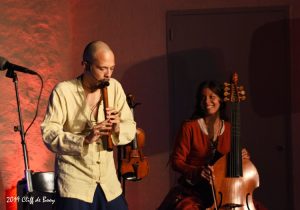 Robin shares her love for old English times and creating music with Meidi Goh, who has a specific love for the music of Elizabethan England. The period in the Tudor times when Elisabeth 1st ruled (1558 – 1603) and Englands most famous son, Shakespeare, lived. Meidi is not classicly trained as such. She got a deep love the Viola da Gamba -the bass viol- and Renaissance music through her mother, who played in a recorder quartet. She started taking lessons with a Baroque violinist and then turned towards the tenor viol and singing. Her love for folk started when she joined the Dutch band
AmmA,
and she loved the freedom it gave her to improvise and create her own music, a freedom that accumulated in her first solo CD
Heartstrings
that came out earlier this year.
Remy Schreuder (picture left) is the third vocalist of the band and he is also a virtuoso on recorder and cornett – an early wind instrument. popular in Renaissance and Baroque times.
Remy is classicly trained from a young age, and – just as Robin and Meidi- stepped away from the sheet music at a certain point to enroll in a musical training course, which taught him to play different styles of contemporary music: pop, jazz, blues, and even metal. It also taught him the skills of solo improvisation. At the moment he’s studying at the Historical Performance Department of the Conservatorium Utrech, all skills he puts to good use in Imbue.
Laurens Kah is Imbue’s Irish bouzouki player. He has had classical piano lessons from an early age and then took a detour through heavy metal. But the love for, as he describes it, “peaceful piano music”, which he kept through that time, brought him to folk music, where he now not only shares the stage with Imbue, but also with the folk band
Pyrolysis
as an accordionist.
Robin shares her love for old English times and creating music with Meidi Goh, who has a specific love for the music of Elizabethan England. The period in the Tudor times when Elisabeth 1st ruled (1558 – 1603) and Englands most famous son, Shakespeare, lived. Meidi is not classicly trained as such. She got a deep love the Viola da Gamba -the bass viol- and Renaissance music through her mother, who played in a recorder quartet. She started taking lessons with a Baroque violinist and then turned towards the tenor viol and singing. Her love for folk started when she joined the Dutch band
AmmA,
and she loved the freedom it gave her to improvise and create her own music, a freedom that accumulated in her first solo CD
Heartstrings
that came out earlier this year.
Remy Schreuder (picture left) is the third vocalist of the band and he is also a virtuoso on recorder and cornett – an early wind instrument. popular in Renaissance and Baroque times.
Remy is classicly trained from a young age, and – just as Robin and Meidi- stepped away from the sheet music at a certain point to enroll in a musical training course, which taught him to play different styles of contemporary music: pop, jazz, blues, and even metal. It also taught him the skills of solo improvisation. At the moment he’s studying at the Historical Performance Department of the Conservatorium Utrech, all skills he puts to good use in Imbue.
Laurens Kah is Imbue’s Irish bouzouki player. He has had classical piano lessons from an early age and then took a detour through heavy metal. But the love for, as he describes it, “peaceful piano music”, which he kept through that time, brought him to folk music, where he now not only shares the stage with Imbue, but also with the folk band
Pyrolysis
as an accordionist.
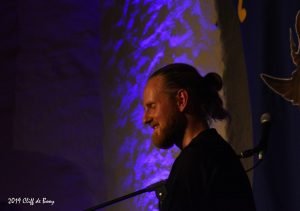 Imbue’s last band member we also know from Pyrolysis: He is of course percussionist and vocalist Tim Elfring. Tim is not classically trained, but equally talented and in his own right is just as important for Imbue’s sound as the other bandmembers. Medieval music sounds totally different from modern music, so Tim helps arrange the old sheet music into a more modern form. How he does that Robin explains herself at the end of this review.
From the introduction of the different band members, it’s already clear what you can expect from Imbue. Ut Solis Radium is filled with 12 beautiful medieval/Renaissance pieces with a good splash of balfolk to cheer it all up. And, I can already reveal, these songs are like honey to your ears.
It starts with the very first notes of Worldes Bliss, two beautiful female voices that instantly grab you. Did I say two female? I make that mistake e-v-e-r-y time I hear the beginning of this 12th century a capella English song. Because it is actually Robin and Remy singing here, so a female and male voice, but Remy has such an amazing range. He easily matches Robin’s voice, not only in height but also in the purity of tone and beauty. Really amazing. I think the official term for it is a countertenor. I know the unofficial term for it is a jawdropping “AMAZING!”
To make things even more impressive in Hanacpachap Cussicuinin – a 17th century Peruvian hymn in Quechua – Remy takes on the bass ánd tenor voice. A simply insane range. But let’s not forget the third beautiful voice that Imbue has, Meidi Goh, also joins in. The first two songs are all about Imbue’s voices. A simple drum, flute, viola da gamba accompanies them, all done in such a controlled delicate way, yet with feeling and intent. When so much musical talent comes together in this way the result is just stunning. A compliment to
Thomas Cochrane
recording and mixing) and
Ferry Verhoeve
(mastering) from the Dutch
E-sound studio,
who together managed to capture every single note, but also every single moment of controlled silence perfectly.
O Madame is a lovely cheerful 16th century song with Remy playing lovely ‘ornaments to the main melody’ on the recorder (a quote from a conversation I had with Robin Lammertink about the new CD that describes Remy’s style of playing perfectly and she added that it is sort of his specialty).
With the next song, J’ai Vu Le Loup, we have another French song, a classic among medieval and folk bands. Always fun to hear and Imbue’s version is no exception.
Imbue’s last band member we also know from Pyrolysis: He is of course percussionist and vocalist Tim Elfring. Tim is not classically trained, but equally talented and in his own right is just as important for Imbue’s sound as the other bandmembers. Medieval music sounds totally different from modern music, so Tim helps arrange the old sheet music into a more modern form. How he does that Robin explains herself at the end of this review.
From the introduction of the different band members, it’s already clear what you can expect from Imbue. Ut Solis Radium is filled with 12 beautiful medieval/Renaissance pieces with a good splash of balfolk to cheer it all up. And, I can already reveal, these songs are like honey to your ears.
It starts with the very first notes of Worldes Bliss, two beautiful female voices that instantly grab you. Did I say two female? I make that mistake e-v-e-r-y time I hear the beginning of this 12th century a capella English song. Because it is actually Robin and Remy singing here, so a female and male voice, but Remy has such an amazing range. He easily matches Robin’s voice, not only in height but also in the purity of tone and beauty. Really amazing. I think the official term for it is a countertenor. I know the unofficial term for it is a jawdropping “AMAZING!”
To make things even more impressive in Hanacpachap Cussicuinin – a 17th century Peruvian hymn in Quechua – Remy takes on the bass ánd tenor voice. A simply insane range. But let’s not forget the third beautiful voice that Imbue has, Meidi Goh, also joins in. The first two songs are all about Imbue’s voices. A simple drum, flute, viola da gamba accompanies them, all done in such a controlled delicate way, yet with feeling and intent. When so much musical talent comes together in this way the result is just stunning. A compliment to
Thomas Cochrane
recording and mixing) and
Ferry Verhoeve
(mastering) from the Dutch
E-sound studio,
who together managed to capture every single note, but also every single moment of controlled silence perfectly.
O Madame is a lovely cheerful 16th century song with Remy playing lovely ‘ornaments to the main melody’ on the recorder (a quote from a conversation I had with Robin Lammertink about the new CD that describes Remy’s style of playing perfectly and she added that it is sort of his specialty).
With the next song, J’ai Vu Le Loup, we have another French song, a classic among medieval and folk bands. Always fun to hear and Imbue’s version is no exception.
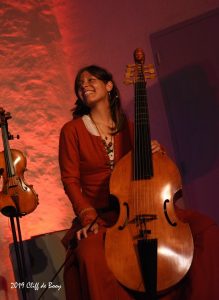 For now, I’ll keep focussing on the cheerful songs, Bobbing Joe is another one that puts a huge smile on my face, its a traditional song with words put to it by Meidi Goh who also took the lead on it, together with the fourth beautiful voice Imbue can put forward, that of Tim Elfring. This is also the main difference between the first album In Quator Tempora and this one, Imbue makes more use of all their vocal talents, making the album more varied.
I have to say I love the cheerful, dancing feel of Bobbing Joe. It is so Meidi Goh. You can hear her sparkling joyful energy in every note she, Tim, Laurens and Remy play. I loved it on her solo album Heartstrings and I love it here too.
It also is the strength of Imbue. That match of classical talent and folk talent together, giving them a unique sound within both the folk- and the classical world
On Stella Splendens Robin shines. How she has grown as a singer since In quatuor Tempora. Mind you what she did on the first album was already impressive, but a couple of years of conservatorium brought out the best of her obvious vocal talent. It’s on moments like this I am grateful my mom used to play classical music a lot so that I learned to appreciate this side of the musical spectrum too. I would have missed so much beautiful music if she hadn’t. Imbue’s wonderful interpretation of this 14th century Latin song would be one.
Hemels Dauwe is a fun song, again different (compliments on the varied song choice Imbue) and in Dutch. It comes from Het Antwerps liedboek (The Antwerp songbook) and has balfolk written all over it. Can medieval music be cool? Well, the answer comes with the stunning last song om Ut Solis Radium. A resounding yes!! As I listen to the beautiful high notes that Robin is hitting in Mirie It Is While Summer Ilast, I can only come to one conclusion. Imbue’s music isn’t building a bridge between two worlds, no it is bringing four worlds together, that of medieval music, the Renaissance, classical chamber music and balfolk. And in a fresh contemporary way at that.
A must-have for all who love historical classical balfolk music.
– Cliff
editor: Sara Weeda
Sleeve art: Robin Lammertink, Meidi Goh
photo’s: Cliff de Booy
PS: As promised Robin Lammertink took some time to explain a bit about the different ways of singing harmonies.
For now, I’ll keep focussing on the cheerful songs, Bobbing Joe is another one that puts a huge smile on my face, its a traditional song with words put to it by Meidi Goh who also took the lead on it, together with the fourth beautiful voice Imbue can put forward, that of Tim Elfring. This is also the main difference between the first album In Quator Tempora and this one, Imbue makes more use of all their vocal talents, making the album more varied.
I have to say I love the cheerful, dancing feel of Bobbing Joe. It is so Meidi Goh. You can hear her sparkling joyful energy in every note she, Tim, Laurens and Remy play. I loved it on her solo album Heartstrings and I love it here too.
It also is the strength of Imbue. That match of classical talent and folk talent together, giving them a unique sound within both the folk- and the classical world
On Stella Splendens Robin shines. How she has grown as a singer since In quatuor Tempora. Mind you what she did on the first album was already impressive, but a couple of years of conservatorium brought out the best of her obvious vocal talent. It’s on moments like this I am grateful my mom used to play classical music a lot so that I learned to appreciate this side of the musical spectrum too. I would have missed so much beautiful music if she hadn’t. Imbue’s wonderful interpretation of this 14th century Latin song would be one.
Hemels Dauwe is a fun song, again different (compliments on the varied song choice Imbue) and in Dutch. It comes from Het Antwerps liedboek (The Antwerp songbook) and has balfolk written all over it. Can medieval music be cool? Well, the answer comes with the stunning last song om Ut Solis Radium. A resounding yes!! As I listen to the beautiful high notes that Robin is hitting in Mirie It Is While Summer Ilast, I can only come to one conclusion. Imbue’s music isn’t building a bridge between two worlds, no it is bringing four worlds together, that of medieval music, the Renaissance, classical chamber music and balfolk. And in a fresh contemporary way at that.
A must-have for all who love historical classical balfolk music.
– Cliff
editor: Sara Weeda
Sleeve art: Robin Lammertink, Meidi Goh
photo’s: Cliff de Booy
PS: As promised Robin Lammertink took some time to explain a bit about the different ways of singing harmonies.
 Robin (middle): ‘The most common vocal style is the monody. This is a solistic vocal melody accompanied by an instrument who plays chords. When you sing with more people you could all sing the same melody; which would be singing in unison. But you could also sing in vocal harmony, which is when all the voices sing in the same rhythm, but different notes from the chord. Or, when every voice has an independent melody, ingeniously intertwining to become one composition, we speak of polyphony.
A good example of singing in vocal harmony is ‘O Madame’ was the second vocals of Meidi are simultaneous with the lead vocals, but on a different pitch, creating a harmony. A polyphonic example from our album is ‘Bobbing Joe’, where Tim’s melody has a different rhythm from Meidi’s melody; he sings long notes, while Meidi sings shorter notes. Btw it’s not only polyphonic, but it’s also polytextual; singing two different texts at the same time. This was actually quite common in the Middle Ages. Speaking of which; ‘A Round of three Country Dances in One’ (which did not end up on our album, but is on our Youtube) is polyphony ánd polytextuality at it’s best! 😉
Another interesting thing about medieval music is that before the 13th century the barline was not invented yet. Meaning there was no ‘pulse’ the way we feel the beat in modern music. Nowadays most music is divided in a 4/4 measure, with four beats in one bar, or a 3/4 measure with 3 beats in one bar. The ‘one’ is usually more accentuated (or ‘heavy’). This is a feeling we as modern music consumers all recognize. The ‘one’ is also very important for dancers.
Before this division in equal chunks of 4 or 3, there would just be a musical sentence with a random amount of beats, simply following the text. So this is where Tim comes in. He is there to find the “one’ in those sentences and create a suggestion of logic. Like for example in Stella Splendens. The first and the fifth bar of the couplet have 5 beats, while the rest have the ‘normal’ 4 beats. This feels strange to our modern ears, so it’s is Tim’s job to camouflage it gently without losing the old charm.”
Robin (middle): ‘The most common vocal style is the monody. This is a solistic vocal melody accompanied by an instrument who plays chords. When you sing with more people you could all sing the same melody; which would be singing in unison. But you could also sing in vocal harmony, which is when all the voices sing in the same rhythm, but different notes from the chord. Or, when every voice has an independent melody, ingeniously intertwining to become one composition, we speak of polyphony.
A good example of singing in vocal harmony is ‘O Madame’ was the second vocals of Meidi are simultaneous with the lead vocals, but on a different pitch, creating a harmony. A polyphonic example from our album is ‘Bobbing Joe’, where Tim’s melody has a different rhythm from Meidi’s melody; he sings long notes, while Meidi sings shorter notes. Btw it’s not only polyphonic, but it’s also polytextual; singing two different texts at the same time. This was actually quite common in the Middle Ages. Speaking of which; ‘A Round of three Country Dances in One’ (which did not end up on our album, but is on our Youtube) is polyphony ánd polytextuality at it’s best! 😉
Another interesting thing about medieval music is that before the 13th century the barline was not invented yet. Meaning there was no ‘pulse’ the way we feel the beat in modern music. Nowadays most music is divided in a 4/4 measure, with four beats in one bar, or a 3/4 measure with 3 beats in one bar. The ‘one’ is usually more accentuated (or ‘heavy’). This is a feeling we as modern music consumers all recognize. The ‘one’ is also very important for dancers.
Before this division in equal chunks of 4 or 3, there would just be a musical sentence with a random amount of beats, simply following the text. So this is where Tim comes in. He is there to find the “one’ in those sentences and create a suggestion of logic. Like for example in Stella Splendens. The first and the fifth bar of the couplet have 5 beats, while the rest have the ‘normal’ 4 beats. This feels strange to our modern ears, so it’s is Tim’s job to camouflage it gently without losing the old charm.”






